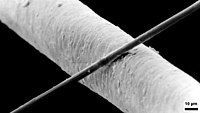
Photo from wikipedia
Abstract Polyurethane/epoxy resin modified asphalt (PEA) has substantial potential in functioning as adhesive layer material for steel-ultra high performance concrete (UHPC) composite bridge deck pavements. In this research, the curing… Click to show full abstract
Abstract Polyurethane/epoxy resin modified asphalt (PEA) has substantial potential in functioning as adhesive layer material for steel-ultra high performance concrete (UHPC) composite bridge deck pavements. In this research, the curing process of PEA was analyzed by Fourier transform infrared spectroscopy (FTIR) and fluorescence microscopy (FM) tests. Furthermore, mechanical and engineering performances of PEA were evaluated and further compared with those of styrene-butadiene-styrene (SBS) modified asphalt by viscosity test, tensile test, pull-out test, and dynamic shear rheometer (DSR) test. Results indicate that during the curing process of PEA, the polyurethane/epoxy resin undergoes a reaction with curing agent to form an interpenetrating polymer network (IPN) structure with a phase transition of polyurethane/epoxy resin from a dispersed phase to a continuous phase. The viscosity of PEA is affected by the asphalt content and temperature. PEA possesses excellent mechanical properties due to the formation of IPN structure and the toughening effect of asphalt. The high-temperature stability of PEA is far better than that of SBS modified asphalt. Additionally, the low-temperature cracking resistance and waterproof performances of PEA can meet the requirements of the adhesive layer well.
Journal Title: Construction and Building Materials
Year Published: 2021
Link to full text (if available)
Share on Social Media: Sign Up to like & get
recommendations!